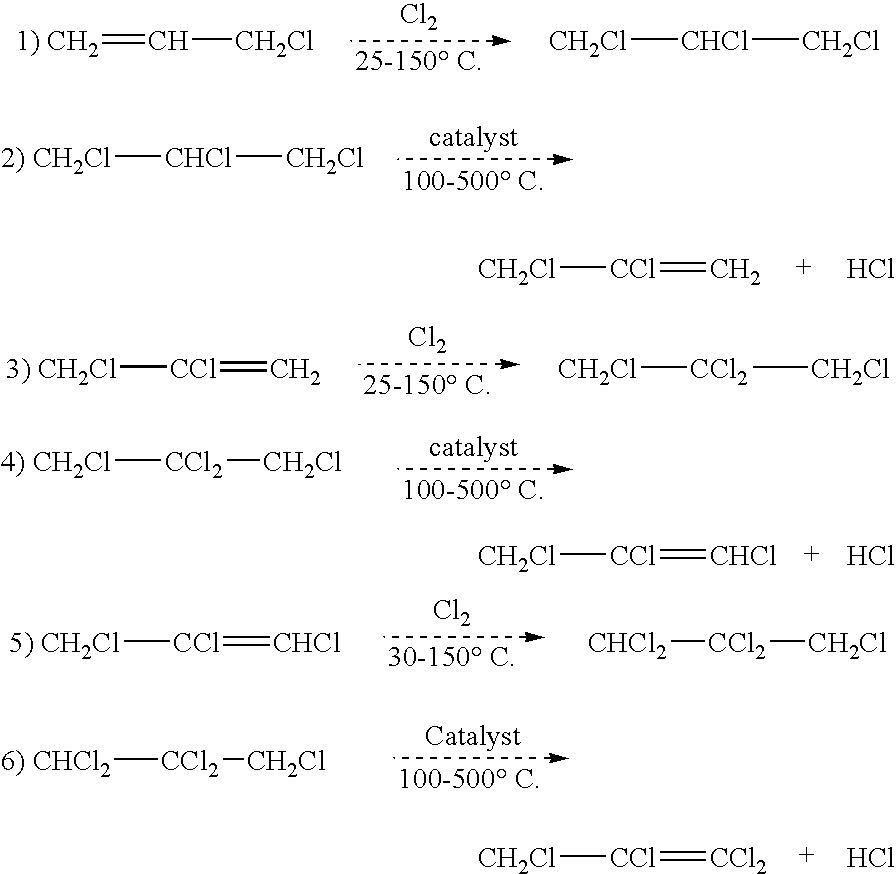Processes for preparing 1,1,2,3-tetrachloropropene
- Summary
- Abstract
- Description
- Claims
- Application Information
AI Technical Summary
Problems solved by technology
Method used
Image
Examples
example 1
Synthesis of CH2ClCHClCH2Cl from Cl2 and CH2ClCH═CH2
[0018]A 250 mL three-necked flask is equipped with stir bar, thermometer, reflux condenser cooling with −50° C. cooling fluid, and Cl2 inlet which is connected to a flow meter and then a Cl2 feed cylinder. The top of the condenser is connected to a scrubber to treat any un-reacted Cl2. The reactor is heated in an oil bath to control inside temperature to about 45° C.-50° C. About 100 g of CH2═CHCH2Cl is added to the flask, and then Cl2 is bubbled into the CH2═CHCH2Cl at a rate of about 5 to about 10 grams per hour while the mixture is continuously stirred. The progress of the reaction is monitored by gas chromatography. Chlorination is continued until the conversion of CH2═CHCH2Cl is about 95% or greater, and the major component in the reaction product is CH2ClCHClCH2Cl, which is preferably present in an amount of at least about 90 mole % of the reaction product.
example 2
Synthesis of CH2ClCCl═CH2 from CH2Cl —CHClCH2Cl
[0019]A ½″ OD×36″ long reaction tube is prepared by charging the tube with about 65 cc of Cr2O3 catalyst. A thermocouple is inserted into the center of the catalyst bed to monitor reaction temperatures. A coiled section of 10 ft length of ¼″ OD monel tube is connected to the reactor inlet and serves as a vaporizer / superheater for the organic feed that is being introduced. The vaporizer and reaction tube are heated by a sand bath until the catalyst bed temperature is about 350° C. CH2ClCHClCH2Cl, preferably as produced by the reaction product of Example 1, is fed (preferably via a peristaltic pump) at a rate of about 9 to about 10 grams per hour. Product is collected in a cold trap (product collection cylinder) for a total of about 2 hours. The organic recovered is analyzed using GC. The GC results show about 90% or greater conversion of CH2ClCHClCH2Cl. The major product is CH2ClCCl═CH2, preferably being present in the reaction product i...
example 3
Synthesis of CH2ClCCl2CH2Cl from CH2ClCCl═CH2 and Cl2
[0020]The same reaction apparatus as in Example 1 is used. The reactor is heated in an oil bath to control the inside temperature of from about 45° C. to about 50° C. About 100 g of CH2ClCCl═CH2 is added to the flask. Chlorine is bubbled into the CH2ClCCl═CH2 at a 5-10 grams per hour. The reaction is allowed to proceed until a 85% or greater conversion of CH2Cl—CCl═CH2 is achieved, and the major product is CH2ClCCl2CH2Cl, which in preferred embodiments is present in the reaction product in amounts of from about 85 mole % or greater.
PUM
| Property | Measurement | Unit |
|---|---|---|
| Temperature | aaaaa | aaaaa |
Abstract
Description
Claims
Application Information
 Login to View More
Login to View More - R&D
- Intellectual Property
- Life Sciences
- Materials
- Tech Scout
- Unparalleled Data Quality
- Higher Quality Content
- 60% Fewer Hallucinations
Browse by: Latest US Patents, China's latest patents, Technical Efficacy Thesaurus, Application Domain, Technology Topic, Popular Technical Reports.
© 2025 PatSnap. All rights reserved.Legal|Privacy policy|Modern Slavery Act Transparency Statement|Sitemap|About US| Contact US: help@patsnap.com

